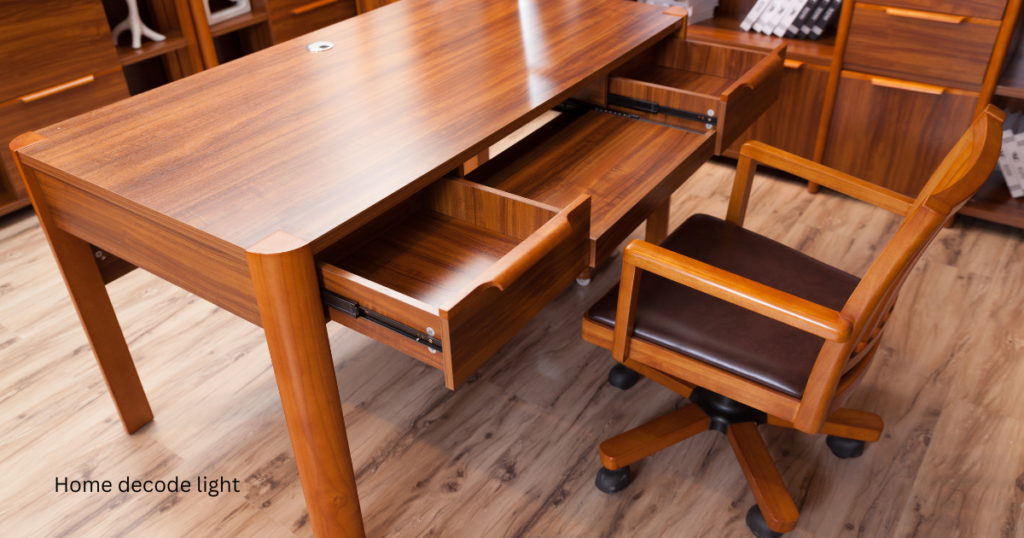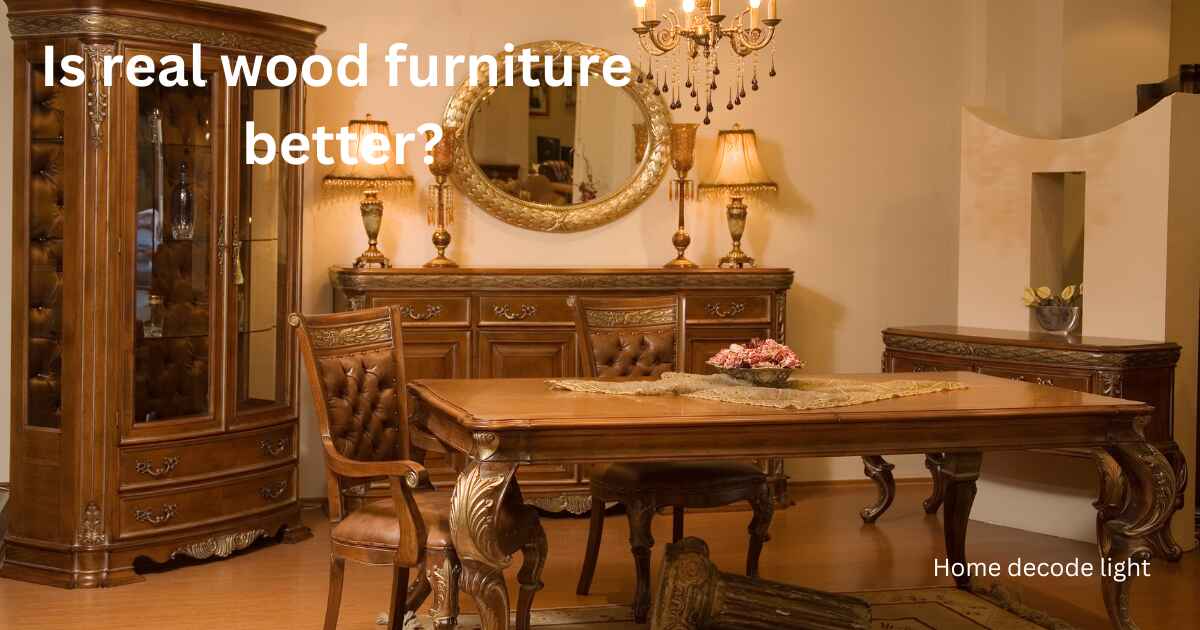Is real wood furniture better?: Solid wood is more durable by nature than plywood laminates. It can endure wear and tear for longer without showing any signs of damage.
With proper care, solid wood furniture can last generations. It is a long-term investment that will pay off. Over time, plywood laminates can wear out or delaminate.
Solid wood has a natural, authentic appearance. Its grain patterns are rich and have a unique character. This natural beauty will enhance the aesthetic appeal of any space, and it will age gracefully as it develops a patina.
Solid wood is more durable and less likely to have structural problems than plywood laminates. It can withstand heavy loads and repeated use without deteriorating.
Solid wood furniture is a great investment because it tends to retain its value or increase over time. Plywood laminates have a lower resale price. [Is real wood furniture better?]
7 most durable types of wood are best for furniture
- Teak
- Maple
- Cherry
- Mahogany
- Birch
- Acacia
- Ipe
1. Teak
Teak (genus Tectona grandeis), a large deciduous tree of the Verbenaceae family, or its wood, is one of the most precious timbers.
Since more than 2,000 BC, Teak has been used extensively in India. The Malayalam term tekka is the source of the name Teak.
A straight, often buttressed stem distinguishes it. The base of the tree is thickened. It has four-sided branchlets with large quadrangular pitches.
Young specimens may have opposite or whorled leaves. The plants are roughly 0.5m long and 9in wide.
Their shape is similar to that of tobacco plants but is harder and has a rougher surface. Heartwood is a golden-yellow wood with a pleasant aroma.
In warm countries, teak wood is prized for its exceptional durability. You can find beams in excellent condition in many old buildings in India and Myanmar. [Is real wood furniture better?]

2. Maple
Acer, a large group of trees and shrubs in the Sapindaceae family, is mainly found in China but widely distributed throughout the North Temperate Zone.
Maples are among the most popular ornamentals to be planted in lawns, parks, and along streets. Many of them display beautiful fall colours.
Some produce maple sugar, and others provide dense, hard hardwood that can be used for furniture. All maples have winged seeds called keys.
The leaves are arranged in opposite directions on the twigs. Some maples have leaflets, while others have lobed leaves.
Campestre and Amur, or ginnala, maple A. The Amur or ginnala maple A. Both ginnala and campestre are suitable for screens or hedges. The Japanese maple is A.
Over centuries of breeding, palmatum has produced a wide range of attractive cultivars with different leaf shapes and colours. [Is real wood furniture better?]
Read Also: Does wooden furniture absorb sound?
3. Cherry
A Cherry is any tree belonging to the Prunus genus and its edible fruit. Tart cherries (Prunus cerasus) are used for sauces, pastries, and canning and are available for commercial production.
Sweet cherries (Prunus avium) and tart cherries (Prunus cerasus) also make up the commercial cherry production. Avium is the main type of maraschino preserved and consumed in liqueur.
Several species, hybrids and cultivars, are grown for their abundant spring flowering, and the dark-red wood is particularly valued for fine furniture.
The majority of cherry species are native to the Northern Hemisphere. North America has 10 to 12 cherry species, and Europe has several.
The greatest concentration of species is in eastern Asia. It is believed that the native habitat of the cultivated cherry species was in Eastern Europe and Western Asia, from the Caspian Sea up to the Balkans. [Is real wood furniture better?]

4. Mahogany
Mahogany is any of several tropical hardwood trees, particularly certain species from the family Meliaceae. Swietenia mahagoni is one such tree which comes from tropical America.
This is a tall Evergreen Tree with hardwood. It turns reddish-brown at maturity. Each large leaf has several leaflets arranged in a feather-like pattern but no terminal leaflet.
The white flowers appear in clusters, and the fruit is an oval, winged capsule with five squarish parts. Most commercial mahogany comes from other genera, like the African Khaya or Entandophragma.
The structure and species make up a tropical forest depending on how much rain falls. Forests in areas with higher rainfall tend to have taller trees and more Evergreen Species.
Those in dry areas have lower canopy heights and fewer species. These communities are home to many vines and herbaceous Epiphytes. [Is real wood furniture better?]
Read Also: Which outdoor furniture is the easiest to maintain?
5. Birch
Birches have a smooth, white or varicoloured bark marked by horizontal pores. This bark usually peels in thin sheets and is found on young trees.
The thick, deeply furrowed trunk bark on older trees breaks into irregular plates. The short, slender branchlets on a young tree form a pyramidal Crown.
As they age, these branches become more horizontal and pendulous. The egg-shaped, triangular leaves are usually pointed and have toothed edges.
They are alternately arranged along the branchlets. The leaves are bright green and turn yellow in the autumn. The male cats bloom before the leaves appear.
On the same tree, the smaller upright female catkins develop into cone-like clusters that disintegrate when they mature and release tiny one-seeded winged nuts. [Is real wood furniture better?]

6. Acacia
Acacia (genus Acacia) consists of 160 species of pea trees and shrubs (Fabaceae). The acacias are native to tropical and subtropical areas of the world.
They are particularly common in Australia, called wattles, and in Africa, especially in veld and Savanna.
The leaves of Acacias are small, finely divided leaflets. They give the leafstalk a feathery appearance (i.e. pinnate). Many Australian and Pacific species have either suppressed or absent leaflets.
The leafstalks, called petioles, are flattened and perform the same physiological functions as leaves. Leafstalks can be arranged vertically, with thorns, sharp curved prickles, or a rounded prickle at the base. [Is real wood furniture better?]
7. Ipe
Jensen Outdoor takes pride in its 25-year history, sourcing sustainably and adding value to trees that are more than 100 years old from tropical dry forests.
Ipe hardwood is the cornerstone of our legacy. It’s a wood that’s prized for both its beauty and durability.
When paired with Jensen Outdoor’s vertically integrated design and craftsmanship, the strikingly beautiful shades of chocolate brown Ipe timber enhance any decor in timeless style.
Ipe is a premium hardwood that has a high density. This fine hardwood is two times harder than Teak and is much more water- and flame-resistant. Top designers, builders, and individuals have used it for outdoor furniture and flooring for over a century.
Ipe’s remarkable resilience protects against damage, fading, cracking, and warping caused by weather, wear and time. [Is real wood furniture better?]

Conclusion:
Real wood furniture is a great investment because of its durability, beauty that endures, and ability to refinish. It may be more expensive than manufactured alternatives, but its durability and customization potential often outweigh the initial cost. Real wood furniture can be a great choice for quality and sustainability. [Is real wood furniture better?]
Is real wood furniture better?: FAQ
1. What are the advantages of real wood furniture?
Ans: Real wood furniture has a timeless aesthetic, is durable, and long-lasting. Refinishing and repairing it can extend its life.
2. Is real wood furniture more expensive than manufactured alternatives?
Ans: Real wood furniture can be more expensive because of the materials used and the craftsmanship. It is often a more profitable investment in the long run.
3. How does real wood compare to engineered wood?
Ans: Real wood is more durable, unique, and can be refinished.
